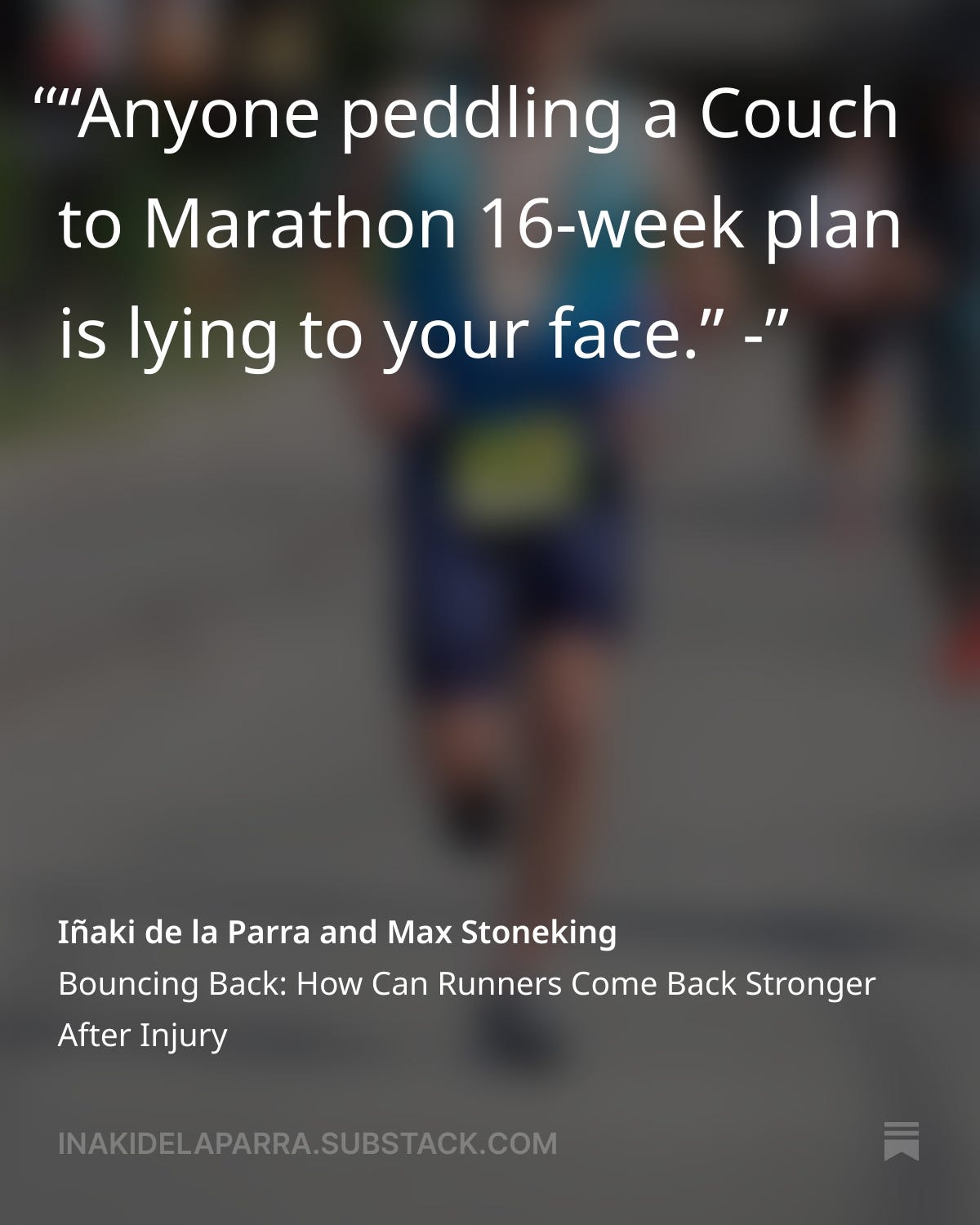In a recent feature article with
(that you should check out by the way HERE), I made the following comment:Admittedly, that was a bit brash. Some athletes do survive those plans. But as a rehab professional who works with runners every day, I tend to see the other side—the injuries, the setbacks, the burnout. And if I’m seeing it this often in the clinic, it suggests there’s something fundamentally flawed in that approach.
This week, we’re going to look at a more rational way for beginners to “go long.” It’s not that you can’t run a marathon, half marathon, or even an Ironman. You absolutely can. But you need to respect the process and build in a way that avoids the traps of injury, illness, and exhaustion.
Ramping volume
If you’ve done no running, the first step is obvious: you need to run more. That’s the only way forward. But how you increase your training volume matters just as much as the increase itself.
Too many beginner plans use an aggressive week-to-week ramp, aiming for a hypothetical “peak week” that supposedly prepares you to finish the race. Here’s the problem: while your aerobic system (heart and lungs) can often adapt quickly, your tendons, bones, and muscles run on a much slower schedule. It can take a year or more to go from brand-new runner to being mechanically durable enough for the training required to thrive in a marathon, half marathon, or long-course race. Walking across the finish line might qualify as achieving your goal, but is that the experience you are looking for?
If you push that timeline too hard, you end up with bone stress injuries, tendinitis, or muscle strains. The engine gets strong fast, but the chassis isn’t built to handle it.
And let’s be clear: there is no shortcut to this process. No magic strength program, no hill workouts, no monster long runs will speed it up. The only answer is time.

Building blocks—Where to focus
If you are going to truly give it time, it can be helpful to zoom out and look further down the road than next week or next month. In my coaching and racing experience, rushing to marathon or half marathon fitness as a beginner leaves you prone to missing some important steps.
If you have no experience in the sport of running, would it not make sense to perhaps look to race a 5K or 10K first to see if you even like to run? If you like to run, you are more likely to show up and when you show up, you can persist long enough to set up your foundation to transition to longer racing.
With that out of the way, lets look at some more technical components to building your foundation—
Density of volume/intensity
When you look at your weekly training, compare it to the distance or duration of your goal race. A common mistake is barely fitting 13 miles, 26 miles, or a 50K into a single week of training before attempting to race that same distance. If you can’t cover that distance in seven days, how can you expect to handle it in one shot on race day?
Of course, you don’t start there if you’re coming off the couch. Ten miles a week may be more than enough for a while. This is especially true if there is an intensity component in your program (there should be!).
You also won’t finish your marathon build on only 26 miles a week either. You may need 40–50. It’s not a hard rule, but a helpful heuristic and a minimum worth aiming for.
With some first-time athletes, we’ve stayed at just 10 miles a week for an entire month while monitoring signs of adaptation. The metrics I track include:
Subjective soreness and fatigue
Workout performance
Pace improvements at easy intensity
General mood and mental state
You don’t add volume just because you hope it will make you fitter. You add volume when the body gives you permission.
This guideline works well for standard distances, but when you move into extreme endurance events (like 100-mile ultras), the equation changes. Some athletes do train 100 miles a week successfully, but they almost always have years of experience behind them. For most beginners, a 100-mile ultra should not be the first target.
Cross training
Some folks think cross-training is a hack that speeds up running development. It’s not exactly that, but it does help.
Cross-training (cycling, swimming, rowing, hiking) allows you to build aerobic fitness without adding more pounding from running. Since most beginners are limited mechanically, not aerobically, this is a smart way to keep progressing. Aerobic capacity develops relatively quickly and can be trained in many ways; tendons and bones, on the other hand, need much more time as we mentioned.
Take swimmers as an example. Many former swimmers can run surprisingly fast on relatively low mileage. They’ve built huge aerobic engines, but they lack the mechanical durability to handle higher run volumes without breaking down. Could they get faster if they ran more? Sure—but often at the cost of injury. The timeline matters.
We see a similar effect in triathlon. Plenty of triathletes put up strong running performances on modest run mileage, thanks to hours of aerobic work on the bike and in the pool. It’s a reminder that aerobic fitness crosses boundaries.
Maybe we should all just be doing triathlon.
Long runs
The long run has earned its reputation for good reason. When planned and progressed appropriately, it provides one of the biggest returns on investment in training. This is even backed up in some literature in a great new paper from Zanini et. al 2025. I will link that paper HERE for you to peruse.
The long run is all about durability, and I have already covered how you can improve your durability in the series linked below:
The Durable Athlete—Part I
Fitness is a loaded term. It could mean crushing long distances, having great sprint ability, or showcasing raw power. But the thread that ties it all together is durability.
In that study, runners who performed 90-minute long runs showed greater improvements in running economy and experienced less muscular fatigue compared to those running 70 minutes. While the study can’t prove cause-and-effect, it highlights the unique adaptations that can occur when you extend your endurance sessions.
It also makes practical sense: most long-distance races take far longer than 70 minutes unless you’re exceptionally fast. Progressing toward runs that approach race duration prepares both the body and mind for what’s coming.
Of course, “long” is always relative. For an experienced marathoner, it might mean 20 miles every Sunday. For a new runner, it might mean 5 miles. What matters is the habit of regularly including a run that stretches your current limits just enough to build durability. Over time, your long run should grow with you, eventually incorporating race-specific elements as your event approaches.
One caveat: the long run only delivers its benefits when it fits logically within your program. Randomly cranking out big miles without context is more likely to leave you broken than prepared.
Have some patience
The trap most beginners fall into is impatience. They want the race before they’ve built the runner. Your first marathon, half marathon, or long distance triathlon doesn’t have to be about survival. It can be the start of a sustainable, enjoyable relationship with the sport. Build patiently, train wisely, and when race day comes, you’ll have the well-rounded fitness to succeed.



